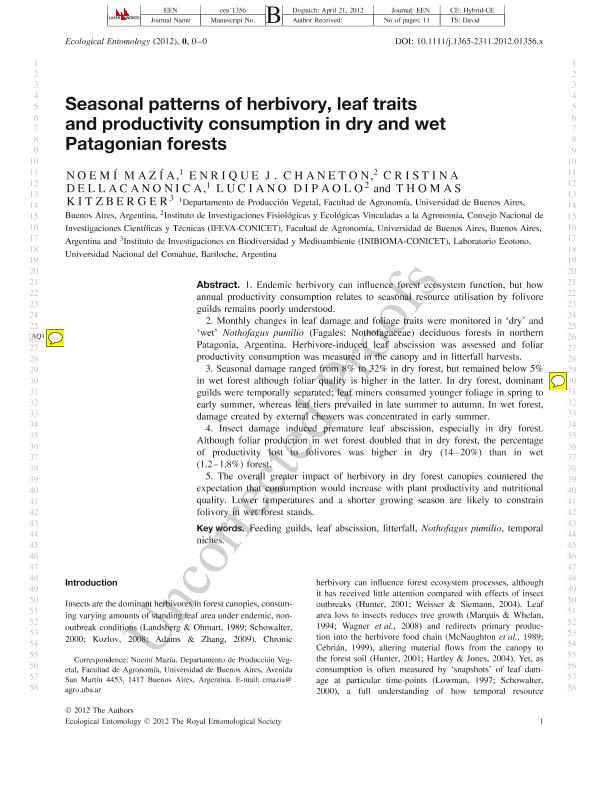Artículo
Seasonal patterns of herbivory, leaf traits and productivity consumption in dry and wet Patagonian forests
Mazía, Cristina Noemí; Chaneton, Enrique Jose ; Dellacanonica, Cristina; Dipaolo, Luciano; Kitzberger, Thomas
; Dellacanonica, Cristina; Dipaolo, Luciano; Kitzberger, Thomas
 ; Dellacanonica, Cristina; Dipaolo, Luciano; Kitzberger, Thomas
; Dellacanonica, Cristina; Dipaolo, Luciano; Kitzberger, Thomas
Fecha de publicación:
06/2012
Editorial:
Wiley Blackwell Publishing, Inc
Revista:
Ecological Entomology
ISSN:
0307-6946
Idioma:
Inglés
Tipo de recurso:
Artículo publicado
Clasificación temática:
Resumen
1. Endemic herbivory can influence forest ecosystem function, but how annual productivity consumption relates to seasonal resource utilisation by folivore guilds remains poorly understood. 2. Monthly changes in leaf damage and foliage traits were monitored in 'dry' and 'wet'Nothofagus pumilio (Fagales: Nothofagaceae) deciduous forests in northern Patagonia, Argentina. Herbivore-induced leaf abscission was assessed and foliar productivity consumption was measured in the canopy and in litterfall harvests. 3. Seasonal damage ranged from 8% to 32% in dry forest, but remained below 5% in wet forest although foliar quality was higher in the latter. In dry forest, dominant guilds were temporally separated; leaf miners consumed younger foliage in spring to early summer, whereas leaf tiers prevailed in late summer to autumn. In wet forest, damage created by external chewers was concentrated in early summer. 4. Insect damage induced premature leaf abscission, especially in dry forest. Although foliar production in wet forest doubled that in dry forest, the percentage of productivity lost to folivores was higher in dry (14-20%) than in wet (1.2-1.8%) forest. 5. The overall greater impact of herbivory in dry forest canopies countered the expectation that consumption would increase with plant productivity and nutritional quality. Lower temperatures and a shorter growing season are likely to constrain folivory in wet forest stands.
Palabras clave:
FEEDING GUILDS
,
LEAF ABSCISSION
,
LITTERFALL
,
NOTHOFAGUS PUMILIO
,
TEMPORAL NICHES
Archivos asociados
Licencia
Identificadores
Colecciones
Articulos(IFEVA)
Articulos de INST.D/INV.FISIOLOGICAS Y ECO.VINCULADAS A L/AGRIC
Articulos de INST.D/INV.FISIOLOGICAS Y ECO.VINCULADAS A L/AGRIC
Articulos(INIBIOMA)
Articulos de INST. DE INVEST.EN BIODIVERSIDAD Y MEDIOAMBIENTE
Articulos de INST. DE INVEST.EN BIODIVERSIDAD Y MEDIOAMBIENTE
Citación
Mazía, Cristina Noemí; Chaneton, Enrique Jose; Dellacanonica, Cristina; Dipaolo, Luciano; Kitzberger, Thomas; Seasonal patterns of herbivory, leaf traits and productivity consumption in dry and wet Patagonian forests; Wiley Blackwell Publishing, Inc; Ecological Entomology; 37; 3; 6-2012; 193-203
Compartir
Altmétricas



